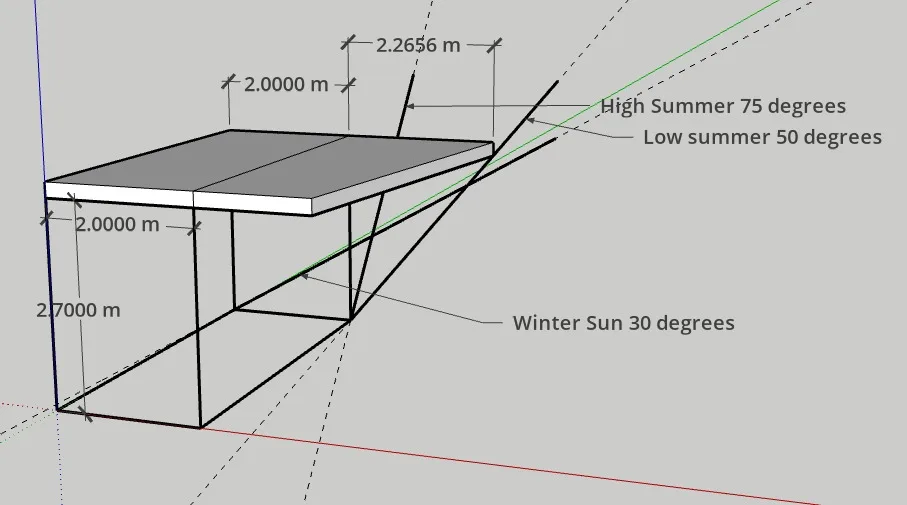In today’s world, where sustainability is becoming increasingly important, direct gain passive solar systems offer an innovative and efficient solution. By harnessing the power of the sun, these systems bring numerous benefits to both residential and commercial buildings. In this article, we will explore the key aspects of direct gain passive solar systems, from understanding their principles to maximizing energy efficiency. At ECS we use this principle when designing south-facing terraces. The principle is shown in the photo above, light and heat to the terrace in winter while keeping it shaded and cool in summer.
Understanding Direct Gain Passive Solar Systems
Direct gain passive solar systems are designed to take advantage of the sun’s heat and light directly. The basic principle is to allow the sunlight to enter the building’s interior, where it gets absorbed by thermal mass materials such as clay, diathonite, concrete, stone and wood. These materials store the heat and release it slowly, thereby maintaining a comfortable temperature inside even when the sun is not shining.
One of the main advantages of direct-gain passive solar systems is their simplicity. Unlike active solar systems that rely on mechanical components, direct gain systems operate naturally, requiring little maintenance or energy input. Moreover, they can be easily integrated into the design of new buildings or retrofitting existing structures.
Direct gain systems work effectively in a variety of climates, from sunny regions to colder areas. In regions with cold winters, the thermal mass materials absorb the heat during the day and release it at night, helping to reduce heating costs. In warmer climates, proper shading and ventilation can prevent overheating, ensuring a comfortable indoor environment throughout the year.
Another key benefit of direct-gain passive solar systems is their cost-effectiveness. By harnessing the sun’s energy for heating and lighting, buildings can significantly reduce their reliance on traditional heating and lighting systems, leading to long-term savings on energy bills. Additionally, the use of natural light can create a more pleasant and productive indoor environment for occupants.
Benefits of Implementing Direct Gain Passive Solar Systems
Implementing direct-gain passive solar systems offers a multitude of benefits that go beyond energy efficiency. Firstly, these systems provide ample natural lighting, reducing the need for artificial lighting during daylight hours. This not only saves energy but also creates a more comfortable and productive indoor environment.
Secondly, direct-gain passive solar systems can significantly reduce heating costs. By utilizing the sun’s energy, they lessen the reliance on traditional heating methods, thus lowering utility bills and making buildings more affordable to operate in the long run.
Additionally, these systems contribute to environmental sustainability by reducing carbon emissions. By relying on the sun’s energy, direct gain passive solar systems reduce the need for fossil fuels, consequently helping combat climate change and promoting a cleaner, greener future.
Furthermore, the design and implementation of direct gain passive solar systems require careful consideration of factors such as building orientation, window placement, and thermal mass. These systems are most effective when integrated into the initial architectural plans of a building, ensuring optimal performance and energy efficiency.
Moreover, the use of passive solar systems can enhance the overall aesthetics of a building. Large south-facing windows, strategically positioned to capture the sun’s rays, not only serve a functional purpose but also add a visually appealing element to the design, creating a bright and inviting space for occupants.
Design Principles for Direct Gain Passive Solar Systems
Designing an effective direct gain passive solar system requires careful consideration of several key principles. Firstly, the orientation of the building plays a crucial role in optimizing solar gain. Ideally, the building should have south-facing windows, allowing for maximum exposure to the sun’s rays during the winter months when heating is most needed.
Thermal mass selection is another critical aspect of system design. Materials with high thermal mass, such as concrete, brick, or stone, are ideal for absorbing and storing heat. Placing these materials strategically near the windows ensures efficient heat absorption and distribution throughout the space.
Proper insulation is equally important in achieving energy efficiency. By minimizing heat transfer through walls, ceilings, and floors, insulation helps retain the heat gained during the day, preventing it from escaping at night. This helps maintain a comfortable and consistent temperature inside the building.
Furthermore, the design of overhangs or shading devices above the south-facing windows is essential to prevent overheating in the summer months. These shading elements can block the high-angle summer sun while allowing the lower-angle winter sun to penetrate and warm the space.
It is also beneficial to incorporate thermal curtains or blinds that can be drawn at night to further insulate the windows and reduce heat loss. These additional layers help create a thermal barrier, trapping the warmth inside and reducing the need for additional heating during the night.
Components of a Direct Gain Passive Solar System
A direct-gain passive solar system consists of several components that work together to harness the sun’s energy. The most crucial element is the glazing, which allows sunlight to enter the building while minimizing heat loss. Double-glazed or low-emissivity windows are commonly used to provide insulation and reduce heat transfer.
Thermal mass materials, as mentioned earlier, play a key role in absorbing and storing heat. These materials are typically incorporated into the floors, walls, or even furniture, depending on the design and layout of the space.
For effective temperature control, ventilation is necessary. Properly designed vents and openings allow for the controlled exchange of air, helping to regulate the temperature and prevent overheating during the summer months.


Furthermore, shading devices such as overhangs, awnings, or external louvres can be installed to prevent excessive solar gain in the warmer months. To understanding the size of such things climate data needs to be taken into account and the suns angle to calcualte the area that needs protecting. These devices help to block direct sunlight from entering the building, reducing the need for mechanical cooling systems and improving overall comfort.
In addition to thermal mass materials, phase change materials (PCMs) can also be utilised in a direct gain passive solar system. PCMs have the ability to store and release large amounts of energy during phase transitions, such as melting and solidifying, providing a more efficient way to regulate indoor temperatures.
Maximizing Energy Efficiency with Direct Gain Passive Solar Systems
While direct gain passive solar systems inherently offer energy efficiency when used on a home, there are additional measures that can be taken to maximize their effectiveness. One such measure is the use of shading devices, such as awnings or blinds, to prevent excessive heat gain during the summer while still allowing for adequate natural lighting.

Incorporating overhangs can also play a significant role in optimizing solar gain. By strategically positioning overhangs above south-facing windows, they can provide shade during the summer when the sun is higher in the sky and allow sunlight to penetrate during the winter months when the sun is lower. The calculation of their size is ilustrated above based on the sun angle and time of year you need protection.
Furthermore, the selection of building materials can impact the performance of direct-gain passive solar systems. Materials with high thermal mass, such as concrete or brick, can help regulate indoor temperatures by absorbing and releasing heat slowly, thus reducing the need for additional heating or cooling.
As we strive for a sustainable future, direct gain passive solar systems present an opportunity to reduce energy consumption, lower carbon emissions, and create comfortable, well-lit environments. Implementing these systems not only benefits the building occupants but also contributes to a greener and more sustainable world.

